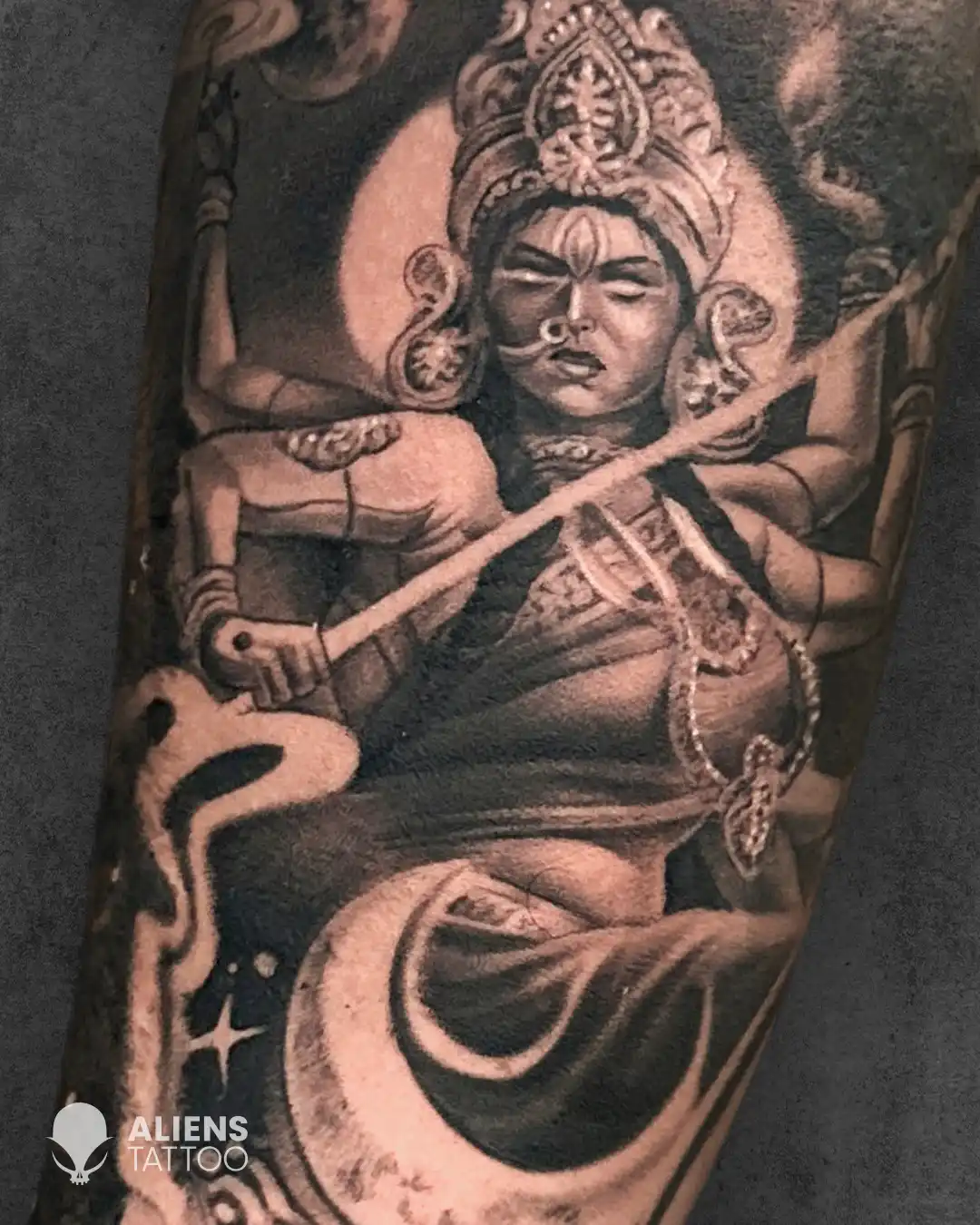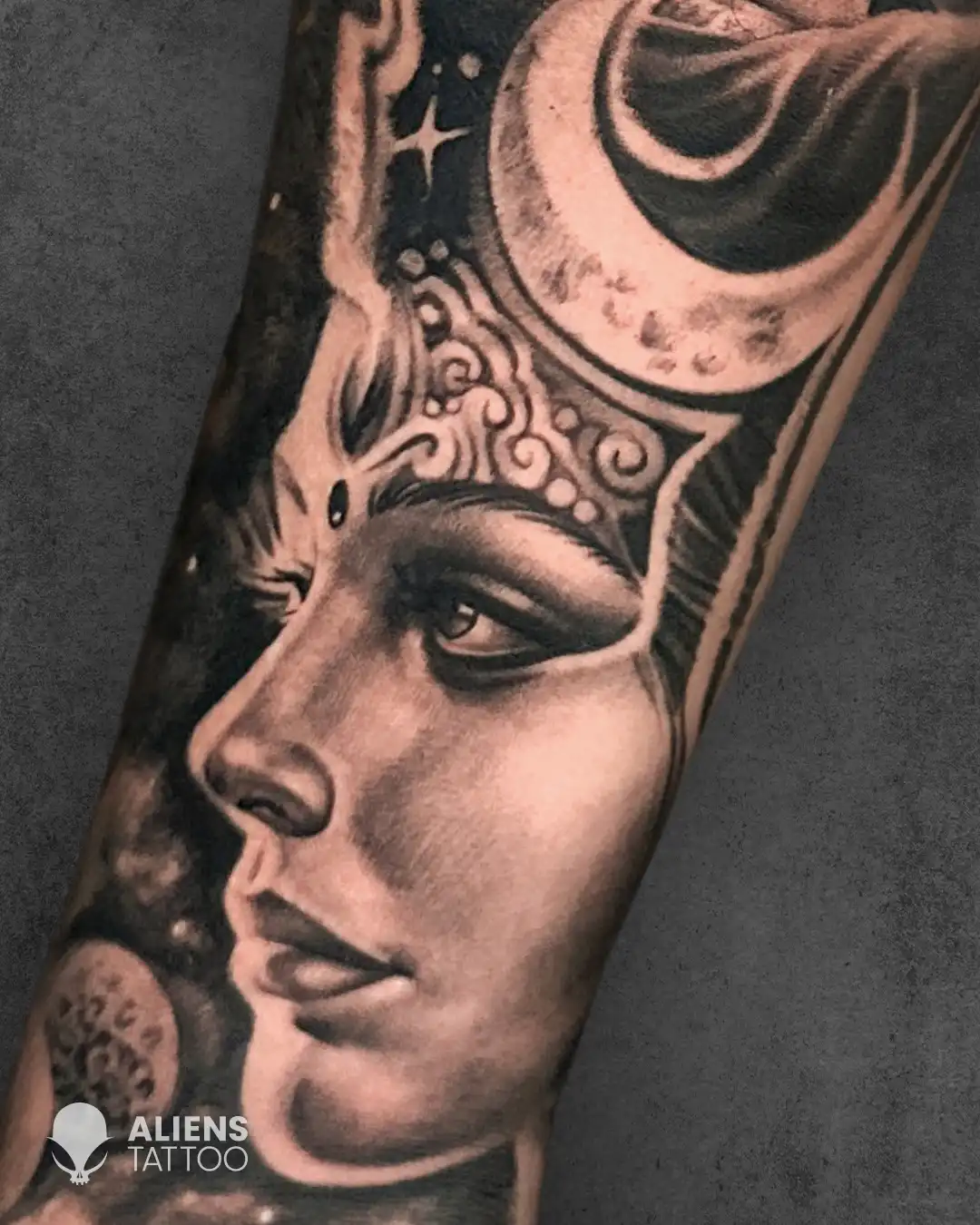
Life often leaves us with scars that go beyond the surface. For Sarthak Sharma, a devoted follower of Mahadev and Kali, a tragic accident resulted in both emotional pain and physical scars on his hands. These scars were a constant reminder of the heartbreaking loss of his brother in that same accident. In the face of this reminder, Sarthak sought to not only cover his scars but also to transform them into a powerful tribute to his brother and his faith.
This is where a deeply meaningful religious cover-up tattoo came into play. Designed and executed by Manoj Laddha, a skilled tattoo artist known for his intricate mythological designs, Sarthak’s tattoo journey became a narrative of healing, strength, and spiritual connection. Over 15 hours, Manoj skillfully covered Sarthak’s scars with a breathtaking mythological tattoo that encapsulated his faith, personal journey, and love for his brother.
The Significance of a Religious Scar Cover-Up Tattoo
For Sarthak, his devotion to Shiva (Mahadev) and Kali runs deep. These two deities symbolize the complete cycle of creation and destruction, representing the balance between life and death. In Hindu mythology, Shiva, known as both the creator and destroyer, embodies this duality. His fierce and powerful form, often referred to as Aggressive Shiva, serves as a strong symbol of resilience, resonating deeply with Sarthak as he navigates the loss of his brother.
Alongside Shiva, Kali holds a significant place in Sarthak’s spiritual beliefs. Kali is the goddess of time, destruction, and rebirth. While she is often depicted in her fierce and intimidating form, her symbolism goes much deeper. Kali represents the destruction of ego and ignorance, paving the way for enlightenment and transformation. For Sarthak, Kali’s presence offers strength, providing him with the resilience to face his grief and move forward in life.
Sarthak chose a religious cover-up tattoo not just to hide the physical scars from his accident but also to represent his journey of spiritual healing and renewal. The tattoo design combined elements of Shiva and Durga, blending mythological symbolism with personal significance. This powerful mix of religious imagery created a tattoo that embodied both Sarthak’s faith and his emotional journey.
The Design: From Pain to Divine Strength
Manoj Laddha, the tattoo artist behind this meaningful piece, had previously collaborated with Sarthak on an Aggressive Shiva tattoo. This earlier work already showcased Sarthak’s deep connection to Mahadev and his belief in the cyclical nature of life—creation and destruction. When Sarthak returned to Manoj, carrying the memory of his brother’s passing and the wish to cover his scars, the tattoo needed to delve deeper. It had to encapsulate his emotional pain, his healing, and his ongoing bond with the divine.
The tattoo took 15 hours to complete, with each element thoughtfully designed to reflect Sarthak’s religious beliefs and personal story. The upper part of the tattoo features Devi Durga, the fierce warrior goddess. Durga, with her many arms wielding divine weapons, symbolizes strength, courage, and protection. For Sarthak, Durga’s fierce form represented the resilience he needed to cope with the loss of his brother and the courage he discovered in his faith.
Durga is celebrated for her role as the protector of the universe, battling against evil and darkness. In the tattoo, she is portrayed in an aggressive stance, showcasing her ability to conquer negative forces. Her multiple arms, holding weapons like the trident, signify her divine power. The trident itself is a symbol often linked to Shiva, reinforcing the connection between the gods in Sarthak’s ersonal narrative.
Below Durga, the tattoo transitions into a tranquil and graceful portrayal of Devi Parvati, the goddess of love, patience, and peace. As Shiva's consort, Parvati embodies the gentler, nurturing side of the divine. Her image in the tattoo balances Durga’s fierceness. While Durga represents the struggle against life's challenges, Parvati signifies healing and love, providing solace and tranquility after turmoil. This dual depiction of the goddess serves as a reminder to Sarthak that life encompasses both conflict and serenity, destruction and creation. The crescent moon on Parvati’s forehead links her to the universe's cycles, reminding Sarthak that even in loss, there is always the potential for renewal and hope.
For Sarthak, this tattoo transcends mere scar concealment; it stands as a deeply personal and spiritual homage to his brother, whose life was tragically ended in the same accident that left Sarthak with his scars. Every aspect of the tattoo is rich with significance—from the cosmic elements to the divine figures—symbolizing Sarthak’s love for his brother and his faith in the eternal cycle of life and death.
Tattoo artist Manoj Laddha reflected on the creative process: “Sarthak’s deep connection to his faith made this tattoo profoundly significant. We weren’t just hiding scars; we were crafting something that could aid in his emotional and spiritual healing. His belief in Shiva’s ability to create and destroy was pivotal to this design, but we also aimed to honor his brother in a way that felt intimate and sacred.”
The process of tattooing was more than just the time spent or the skill required. It was about crafting a piece that would act as a source of strength and healing for Sarthak. As the tattoo developed over 15 hours, it transformed pain into power—a religious cover-up tattoo designed not only to hide physical scars but also to aid in healing the emotional wounds associated with them.
Cosmic Elements: Connecting to the Universe
One of the most captivating features of the tattoo is the cosmic imagery surrounding the deities. Stars, swirling cosmic energy, and celestial symbols like the crescent moon create a sense of the divine and the eternal. For Sarthak, these cosmic elements serve as a reminder that his brother, though no longer physically present, is part of something much larger. The universe illustrated in the tattoo constantly reminds him that life and death are intertwined in a greater cosmic cycle, and that his brother’s spirit continues to exist in the vastness of the universe.
This religious cover-up tattoo has evolved into more than just a means to conceal scars—it has become a link to something beyond the physical realm. Each time Sarthak gazes at his tattoo, he reflects on the cosmic forces at work, the balance between creation and destruction, and the presence of his brother in the universe.
The Emotional Healing Process
For Sarthak, the tattoo has offered emotional healing in ways he didn’t expect. Previously, his hands were a constant reminder of the accident and the scars it left. Now, those scars have been transformed into a religious cover-up tattoo that narrates the story of his faith, strength, and love for his brother. The intricate details, mythological symbols, and personal significance behind every element of the design have facilitated Sarthak's spiritual healing.
This tattoo is not merely body art—it’s a narrative of resilience, faith, and healing. Through Manoj Laddha’s artistry, Sarthak has discovered a way to carry his brother with him always.
Conclusion
Sarthak Sharma’s journey through this religious cover-up tattoo is a powerful testament to the healing power of art and faith. What started as a way to cover physical scars became an emotional and spiritual transformation. The tattoo, with its blend of mythological symbolism, religious devotion, and personal meaning, has become a source of strength, allowing Sarthak to honor his brother while also finding peace in his faith.
For Sarthak, this tattoo is not just ink on skin—it’s a part of his healing journey, a way to remember his brother, and a reflection of his deep connection to Mahadev, Kali, and the cosmic universe. Through the artistry of Manoj Laddha, Sarthak has turned his scars into a symbol of strength, faith, and eternal love.

